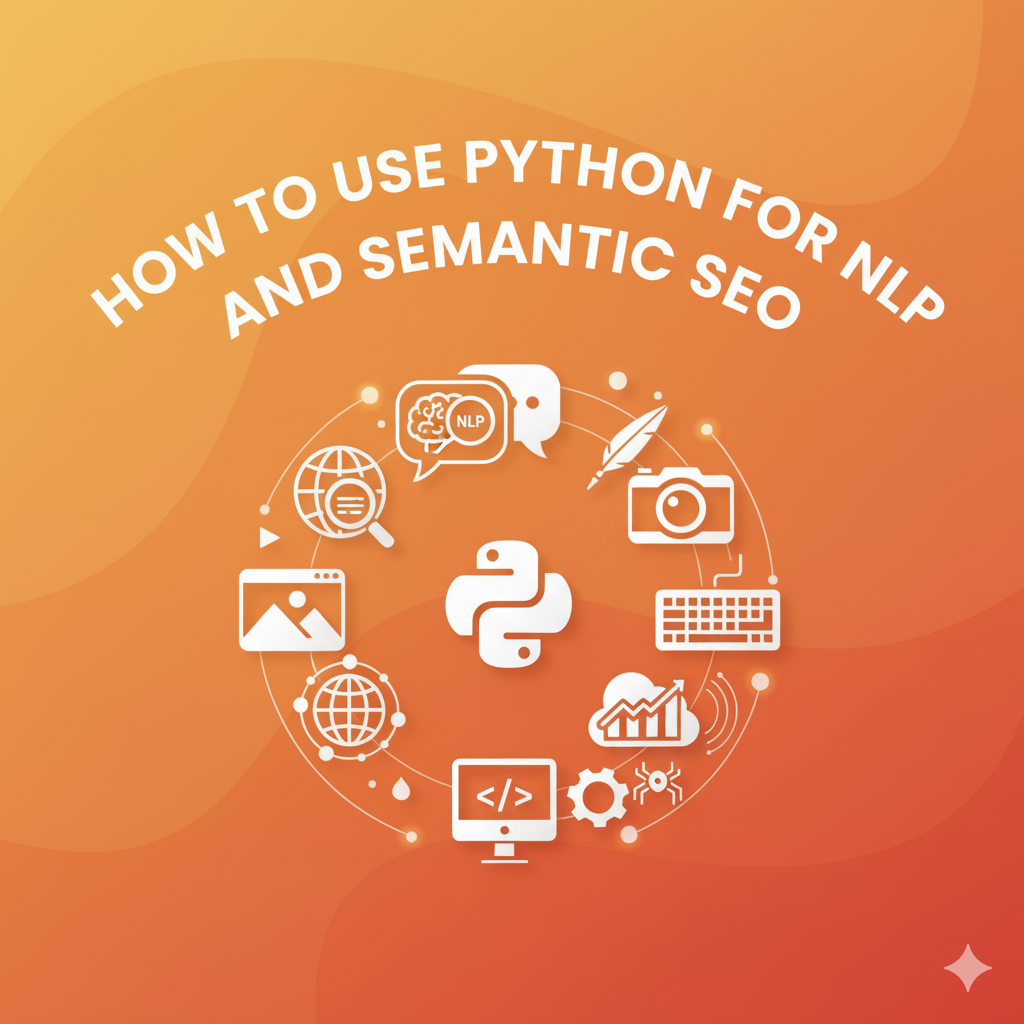You can use Python for Natural Language Processing (NLP) and Semantic SEO to analyze content, extract topics, optimize keyword relevance, and understand user intent. By using libraries like SpaCy, NLTK, and Transformers, you can identify entities, cluster keywords, and improve your content’s topical authority.
Now let’s go in depth and see how Python actually helps SEO professionals and marketers make smarter content decisions.
What is NLP and Why It Matters in SEO
NLP stands for Natural Language Processing. It’s a part of artificial intelligence that helps machines understand human language.
In SEO, NLP helps you go beyond simple keyword targeting. It focuses on understanding meaning, intent, and context.
For example, when someone searches “best camera for travel,” they don’t just want a product list. They want to know which camera is light, affordable, and good for vacations. NLP helps you detect that intent automatically.
That’s exactly what search engines like Google have been doing since BERT and MUM updates. They’re not counting keywords anymore, they’re trying to understand relationships between concepts.
This is where Python comes in. Python gives you access to NLP tools that can process large amounts of text, find semantic relationships, and tell you what your content is really about.
What is Semantic SEO
Before diving into Python, let’s make sure we’re clear on what Semantic SEO means.
Semantic SEO is all about optimizing your content for meaning rather than just individual keywords. It’s how you make your content understandable to both search engines and users.
For example:
Instead of writing five pages targeting “buy shoes online”, “buy sneakers online”, and “buy sports shoes”, you create one strong page about “buying shoes online” that covers related subtopics like sizes, comfort, delivery, and brands.
Google can then semantically understand that your page fully answers the user’s intent. That’s how you build topical authority.
So, Python and NLP help you find what your topic truly covers and what it’s missing.
Why Use Python for SEO
Most SEO professionals rely on tools like Ahrefs, Semrush, or SurferSEO. They’re good, but they don’t show the why behind content gaps or intent relationships.
Python fills that gap. With Python, you can:
- Analyze thousands of keywords at once
- Extract entities and topics from Google SERPs
- Find semantic clusters of related terms
- Identify sentiment and context in user queries
- Automatically generate content briefs
In short, it helps you scale research and optimize smarter.
You don’t have to be a programmer to use it either. A basic understanding of Python syntax and a few ready-made libraries are enough to get started.
Setting Up Python for NLP and SEO
Before we jump into examples, here’s what you’ll need:
Step 1: Install Python
You can download Python from python.org. Choose the latest version and install it.
Step 2: Install Required Libraries
You can install these using pip:
pip install spacy
pip install nltk
pip install pandas
pip install sklearn
pip install transformers
pip install beautifulsoup4 requests
These libraries will cover most of what you need for NLP and SEO tasks.
Step 3: Download NLP Models
SpaCy and NLTK need language models to work properly.
python -m spacy download en_core_web_sm
This downloads a small English model that can detect parts of speech, entities, and sentence structures.
How to Use Python for NLP in SEO
Let’s now get into the fun part — using Python to do actual SEO work.
1. Extract Keywords and Entities from Content
You can use SpaCy to identify named entities (like brands, places, or topics) inside your text. This helps you see what Google might think your content is about.
import spacy
nlp = spacy.load("en_core_web_sm")
text = """Python is a powerful programming language used in AI, NLP, and SEO automation.
Google uses semantic analysis to understand the meaning behind content."""
doc = nlp(text)
for entity in doc.ents:
print(entity.text, entity.label_)
Output:
Python LANGUAGE
AI ORG
Google ORG
This helps you understand which entities are being recognized in your content. If your article is about “machine learning”, but SpaCy can’t find that entity, it means you need to improve contextual relevance.
2. Find Related Topics and Keyword Clusters
Keyword clustering is one of the most powerful uses of Python for Semantic SEO.
Let’s say you have a list of keywords from a tool like Ahrefs. You can group them using their semantic similarity.
from sklearn.feature_extraction.text import TfidfVectorizer
from sklearn.cluster import KMeans
keywords = [
"what is semantic seo",
"semantic search optimization",
"nlp for content marketing",
"how to use python for seo",
"natural language processing seo"
]
vectorizer = TfidfVectorizer()
X = vectorizer.fit_transform(keywords)
kmeans = KMeans(n_clusters=2, random_state=0)
kmeans.fit(X)
clusters = kmeans.labels_
for keyword, cluster in zip(keywords, clusters):
print(f"{keyword} -> Cluster {cluster}")
This groups similar keywords together based on meaning, not just words. You can then create one page for each cluster, which helps build topic relevance.
3. Sentiment Analysis for Content Optimization
Sentiment analysis helps you understand the tone of your content. For example, if you’re writing product reviews, you can check if your tone is neutral or overly positive.
from nltk.sentiment import SentimentIntensityAnalyzer
from nltk import download
download('vader_lexicon')
sia = SentimentIntensityAnalyzer()
text = "Python is an amazing tool for SEO automation but requires some learning."
print(sia.polarity_scores(text))
Output:
{'neg': 0.0, 'neu': 0.72, 'pos': 0.28, 'compound': 0.67}
This tells you if your tone feels balanced. For informational content, aim for a neutral-positive sentiment. For product reviews or brand stories, use more emotional words.
4. Extract Topics from Google Search Results
You can also scrape Google results and use NLP to see what topics competitors cover.
import requests
from bs4 import BeautifulSoup
url = "https://www.google.com/search?q=semantic+seo+guide"
headers = {"User-Agent": "Mozilla/5.0"}
response = requests.get(url, headers=headers)
soup = BeautifulSoup(response.text, "html.parser")
titles = [h.text for h in soup.find_all("h3")]
for t in titles:
print(t)
Now pass these titles through SpaCy or TF-IDF to find the most common topics or terms. It gives you a data-driven way to create outlines.
5. Automate Content Gap Analysis
You can analyze your current content and compare it with the top 10 ranking pages. Using Python, you can find which entities or keywords appear frequently in others’ pages but not in yours.
That’s your semantic gap.
This simple approach helps you create more comprehensive and authoritative content.
Using Transformers for Deep Semantic Analysis
If you want to take things to the next level, you can use models like BERT or Sentence Transformers to find semantic similarity between queries and paragraphs.
from sentence_transformers import SentenceTransformer, util
model = SentenceTransformer('all-MiniLM-L6-v2')
sentences = [
"What is semantic SEO?",
"How does NLP improve content optimization?",
"Python tools for keyword clustering"
]
embeddings = model.encode(sentences)
similarity = util.cos_sim(embeddings[0], embeddings[1])
print(similarity)
This tells you how closely two ideas are related in meaning. You can use it to detect overlapping pages or find if your content covers a topic completely.
How Python Helps in Semantic SEO Strategy
Let’s now connect everything practically.
Here’s how Python fits into your semantic SEO workflow:
- Keyword Research:
Scrape SERPs, extract related queries, and use clustering to group them by meaning. - Entity Optimization:
Analyze your content and identify missing entities related to your topic. - Content Gap Analysis:
Compare your page entities with top-ranking pages. - Content Brief Creation:
Use NLP outputs to generate structured outlines that cover every angle. - Performance Analysis:
Use sentiment and similarity analysis to improve tone and reduce overlap.
In other words, Python makes your SEO smarter, not just more automated.
Real-World Applications of NLP in SEO
Here are a few practical examples of how companies and marketers are already using NLP:
- Semantic Keyword Mapping:
Large agencies map thousands of keywords into topic clusters automatically. - Content Quality Scoring:
NLP models evaluate how well a page answers a query using semantic relevance. - Topic Modeling for Blogs:
Writers use tools built on top of SpaCy or Gensim to find missing subtopics. - Voice Search Optimization:
NLP helps optimize for conversational queries like “how to use Python for SEO.” - Featured Snippet Prediction:
By analyzing sentence structures and intent, you can identify which parts of content might become snippets.
Limitations and What to Avoid
Python is powerful, but it’s not magic.
Here are some things to keep in mind:
- You still need human understanding. NLP gives data, not judgment.
- Over-scraping SERPs can lead to IP blocks. Use delays or APIs.
- Models like BERT need strong hardware. For simple use, stick to SpaCy.
- Don’t rely solely on code for content ideas. Use it to enhance human creativity.
Simple Workflow Example for Semantic SEO
Here’s how you can combine everything into one practical workflow:
- Collect keywords from Ahrefs or Google Search Console
- Use Python to clean duplicates and cluster them semantically
- Analyze top-ranking pages using SpaCy to extract entities
- Compare entities to your existing content
- Identify missing topics and create a new content outline
- Write content manually, guided by these insights
- Re-analyze it to check for tone and coverage
This kind of workflow can easily scale for hundreds of pages without losing the personal touch.
Why Python Gives You an Edge
The main advantage of using Python for NLP and SEO is control.
You’re not limited by what paid tools show. You can customize everything — from how you collect data to how you interpret it.
It also makes you a more strategic SEO professional. You start thinking in terms of relationships and intent, not just volume and competition.
And as search engines continue to get smarter, the future of SEO will be built on understanding context. Python puts you ahead of that curve.
Wrapping Up
Using Python for NLP and Semantic SEO is no longer just for data scientists. It’s for marketers, content strategists, and SEO professionals who want deeper insights.
You don’t have to master machine learning. Start small extract entities, cluster keywords, or analyze topics. Over time, you’ll realize how much smarter your SEO decisions become when they’re backed by language data.
In the end, SEO is about understanding people. NLP and Python simply help you read between the lines.
Yes, Python can be incredibly useful for SEO. In fact, it’s becoming one of the most popular tools among data-driven SEOs today. Python allows you to automate repetitive tasks, extract data from websites, analyze large sets of SEO metrics, and even perform content optimization with the help of Natural Language Processing (NLP).
For example, if you often deal with thousands of URLs, you can use Python scripts to crawl your website, check indexation, find broken links, or detect duplicate content automatically. You can also analyze keyword patterns, compare ranking changes, or audit on-page elements like titles and meta tags in bulk — something that’s hard to do manually.
Tools like BeautifulSoup, Requests, and Selenium are great for scraping and crawling, while Pandas and NumPy help in analyzing the data you collect. If you’re into advanced SEO, you can use spaCy or NLTK for NLP tasks, such as understanding search intent or clustering keywords semantically.
So yes, Python isn’t just for programmers anymore. It’s a powerful SEO ally if you want to save time, scale analysis, and make smarter data-driven decisions.
NLP (Natural Language Processing) helps you understand language the way search engines do. When you use NLP in SEO, your goal is to make content more understandable and contextually relevant for algorithms like Google’s BERT or MUM models.
Here’s how you can use NLP in SEO:
Analyze Search Intent – By running your keywords or queries through NLP libraries like spaCy or Hugging Face Transformers, you can identify whether a query is informational, navigational, or transactional. This helps you tailor your content to match the real intent behind each keyword.
Entity Recognition – NLP can detect named entities (like brand names, locations, or product categories). You can use this to optimize your content for relevant entities and improve topical authority.
Keyword Clustering – Instead of manually grouping keywords, you can use NLP to cluster related keywords automatically based on semantic similarity. This helps in structuring your content around topic clusters.
Sentiment Analysis – NLP can help analyze sentiment in customer reviews or social mentions. You can use it to adjust your brand messaging or even create content that resonates emotionally with your audience.
Content Optimization – NLP tools can identify how often important terms appear and whether your content matches the depth and topic structure that Google expects for a given query.
In short, NLP bridges the gap between what users mean and what your content says. It helps you create content that’s not only keyword-rich but also contextually deep and relevant.
Implementing NLP in Python isn’t as difficult as it sounds. You can get started with a few libraries and a clear goal. Here’s a simple breakdown:
Install NLP Libraries
Start with basic libraries:pip install spacy nltk pandas
For advanced semantic tasks, you can also install:pip install transformers sentence-transformers
Load Language Models
If you’re using spaCy:import spacy nlp = spacy.load("en_core_web_sm") doc = nlp("Python is great for SEO automation and NLP tasks.")
This gives you tokenization, part-of-speech tagging, and entity recognition out of the box.
Perform Common SEO NLP Tasks
Entity Recognition: Extract brands, products, or topics.
Keyword Clustering: Use word embeddings from sentence-transformers to group semantically similar keywords.
Sentiment Analysis: Use TextBlob or VADER to detect tone or opinion.
Topic Modeling: Use gensim with Latent Dirichlet Allocation (LDA) to find main topics in a large set of articles.
Automate and Integrate
Once you set up your workflow, you can integrate NLP results into your SEO reports. For example, you can automatically tag pages by topic, or generate new content ideas based on keyword clusters your model discovers.
So, you don’t need to be a machine learning engineer. With a bit of Python knowledge, you can use NLP to improve SEO efficiency, depth, and performance.
Semantic search focuses on meaning rather than exact keywords. In simple words, it helps your system (or website search feature) understand what users mean when they type a query.
Here’s how to do it using Python:
Use Sentence Transformers
Install and import the library:pip install sentence-transformers
Then:from sentence_transformers import SentenceTransformer, util model = SentenceTransformer('all-MiniLM-L6-v2') sentences = ["best SEO tools", "top keyword research platforms", "Google Analytics alternatives"] embeddings = model.encode(sentences, convert_to_tensor=True)
These embeddings represent sentences in numerical form, allowing you to compare meanings using cosine similarity.
Measure Semantic Similarity
When a user types a query, you can encode it the same way and find which content or keyword has the highest semantic similarity:query = model.encode("SEO automation tools", convert_to_tensor=True) scores = util.pytorch_cos_sim(query, embeddings) print(scores)
The higher the score, the closer the meaning.
Use for SEO Applications
You can apply semantic search for:
Keyword Clustering: Grouping semantically related keywords.
Content Recommendation: Suggesting similar articles to readers.
Topic Expansion: Finding related phrases for long-form content.
Search Engine Improvement: Enhancing your website’s internal search accuracy.
By using semantic search, you can optimize your website for modern search algorithms that focus on context rather than keywords alone. It’s one of the most powerful applications of Python in SEO today.


